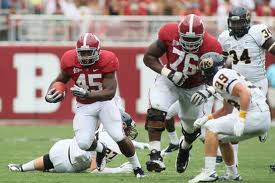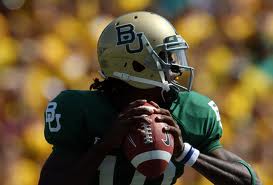Preseason College Football: How Important are Returning Starters?
How important are returning starters when analyzing preseason college football information?
Spring practices are in full swing, fan forums and message boards are lighting up with false hope and wishful thinking and beat writers are trying to convince us that some redshirt freshman has the “potential” to become the next RG3.
But the main topic of conversation this time of year and right up through August always seems to be about Returning Starters. Heck, Phil Steele released his 2012 Returning Starters list in late January.
How Important are Returning Starters?
Common sense would suggest that there is a strong correlation between years with high numbers of returning starters and more wins than losses. However an ESPN article The Importance of Returning Starters cautions otherwise.
[box] An initial look at the numbers reveals that the importance of returning starters may be less than previously thought. Since 2004, FBS teams have averaged approximately 12.97 returning starters per season. Teams with 13 or more starters returning from the previous season won a combined 53 percent of their games during that time period. Teams with 12 or fewer starters won about 50 percent of their games since 2004 — hardly a huge disparity.Even smaller is the difference between experienced squads. Teams with 16 or more returning starters have won about 54 percent of their games since 2004.[/box]
Another good article by College Football Matrix looks at the impact of returning starters broken out by offense, defense and special teams. He seems to suggest that there is a correlation, but that it isn’t as big as many suggest.
Returning Starters is a Flawed Metric
The first problem I have when people start tossing around figures for returning starters is, what constitutes a returning starter? If a senior free safety started 6 games, and a redshirt freshman started the other 6, is the team losing a starter or returning a starter at that position? And what about someone who started 12 games in a previous year but missed last season because of injury or academics? Is he now considered a returning starter?
Different programs, people and publications have different definitions for what constitutes a returning starter. If you read the comments section of the Phil Steele article I mentioned earlier, you will see that nearly every comment disputes the validity of his numbers.
So is a returning starter anyone returning who started x amount of games the previous season? Anyone who has started x number of games throughout their career? Clearly “returning starters” is a flawed measurement.
All Lost and Returning Starters are not Created Equal
I personally don’t concern myself as much with returning starters as I do with overall team starts and experience. And I place even more emphasis on the caliber of the players lost or returning.
Some players are just more important than others, and some schools are better prepared to deal with those losses than others.
For example, according to my numbers Baylor is only losing 5 starters on offense and 3 on defense from last season. But one of those offensive losses is the Heisman Trophy winner. There is no way that Baylor is capable of replacing that loss or replicating the same offensive numbers that they put up in 2011 without him.
Whereas in 2011 Alabama lost a Heisman Trophy winning RB yet didn’t miss a beat last year in the running game because they were able to replace him with a player of equal talent.
In the Alabama case, the loss of a quality player was insignificant; however I suspect we will find out later this year that the loss of RG3 will have a significant impact on Baylor’s overall success.
Some Positions are More Important than Others
Some positions are usually easier to replace than others. In our example above, not only was it easier for a program like Alabama to replace a Heisman Trophy winner than it will be for Baylor, but the running back position is typically an easier position to replace than the quarterback position.
From the same ESPN article I cited earlier:
[box] Certain positions matter more than others when it comes to the correlation between returning starters and next-year success in college football.The positions your returning starters play matters, and it starts at QB. We looked at BCS teams since 2000 to determine which positions were most important to the most successful teams in college football, and discovered that 80 percent of all quarterbacks who have led their teams to a BCS bowl game were returning starters.
Besides quarterback, BCS teams have the highest return rate at offensive tackle (71 percent of tackles on BCS teams are returning starters), cornerback (71 percent) and free safety (72 percent).[/box]
Final Thoughts
A few days ago I wrote an article about betting on the home field advantage in college football. I concluded that while it certainly existed, the overall concept of the home field as a betting advantage was overrated. This is the same conclusion I am making concerning the importance of relying on the simplistic concept of returning starters to cap college football games.
While a correlation between the number of returning starters and future wins or losses does seem to exist, the significance is not nearly as important as most of the college football preseason magazines and so-called experts would have you believe.
I place a lot more value in overall team experience and on the caliber of the players lost or returning. Let’s use Alabama and Baylor as examples again.
[box] According to Phil Steele Alabama only returns 13 starters this season (tied for last in the SEC). The talent that Alabama will be losing from last season’s National Championship team is incredible. Everyone they are losing will be in an NFL camp this fall and at least half of them are ranked in the top 3 at their position.Baylor on the other hand will be returning 16 starters, including 8 from a defense that allowed 512 yard a game against FBS opposition.[/box]
Which school do you believe is more likely to come closer to their win totals from last season? Let me know what you think below. Thanks.
Tags betting on college footballBetting strategiesReturning Starters
- Previous Before You Place Your Bets – You Better Know Your Coaches
- Next College Football Dynasty: Will Nebraska ever be an elite team again?











I understand the point you are trying to make, but I think Alabama and Baylor are poor examples. Alabama is always going to have better talent than Baylor, so they can replace quality starters easier than Baylor.
Kiel, I believe you are correct in assuming that Alabama will almost always have an easier time than Baylor replacing lost talent.
And that is one of the points I am trying to make. You cannot simply look at the “estimated” number of returning starters and assume just because Team A has 16 or 17 starters returning they will be a better team than they were the year before.
There are so many more pieces of the handicapping puzzle to consider when you are trying to determine not only the number of returning starters, but also their importance.
In the example I used, Alabama lost a ridiculous amount of talent, but they still have their starting QB and 4 offensive linemen returning, and they also have a plethora of 5-star recruits to replace all those defensive starters they lost.
Baylor lost the best player in school history at one of the most important positions in football and they return 8 defensive starters to a very bad 2011 defense.
So as a handicapper we need to try and determine how important are the losses to each school? Who are the replacements and what is their talent level? How much improvement, if any, can we expect from the returning starters?
You cannot simply look at the number of returning starters and assume that 16 or 17 is good and 12 or 13 is bad.
I guess I’m of a little different opinion on this subject. I think the number of starters DO matter. But the problem is there are so many variables involved with how much success each team will have. I hate to keep emphasizing coaching in all of these latest articles, but I have very seldom seen a bad or even mediocre coach lead an inexperienced team to a highly successful winning season. But I HAVE seen a good share outstanding coaches do it.
What I mean by variables is there are so many things that can happen to even the most experienced teams during a season. Especially when it comes to avoiding injuries. And the schedule matters too. I’ve seen young teams have great seasons one year when everything fell right, including their schedule and staying injury free. And then return the bulk of their starters the next season, only to fall on their faces from an overly difficult schedule, and/or injuries or coaches moving on.
So you really in no way can say this is a black and white issue with the numbers of returning starters. And to tell you the truth, I think 54% isn’t a bad win/loss record for returning experienced teams. I can work with that number because I can eliminate some of those teams before the season even starts based on coaching/coaching changes and their schedule.
GS, perhaps we disagree on the “importance” of returning starters, however, I believe that the majority of your comment helps to explain some of the points I am trying to make concerning returning starters being a flawed metric.
First since there is no universal definition of what a returning starter is, the same team can have multiple totals depending on who is doing the calculating. Therefore I am not likely to be as impressed by a team’s 17 returning starters if half of them were underclassmen the year before who started a few games each.
But more importantly you point out that “there are so many variables involved with how much success each team will have.” And this is the other point I am trying to make as to why “returning starters” is nowhere near as important as some publications, people and pundits make them out to be.
Coaching is HUGE. Recruiting is HUGE. The Schedule is HUGE. Chemistry, variance (luck), turnovers (more luck), etc.
My point is that anyone who uses returning starters exclusively, without delving deeper into all the other factors involved, is not doing their homework.
It certainly can have some indication on whether or not a team improves (or worsens), but as handicappers it is up to us to determine which teams may fall into which category.
Look at Texas A & M last year. They had more returning starters coming back than nearly every other school in the country, and a lot of those players were (are) NFL or All-conference talents. But as you pointed out in another thread, Sherman sucked as a coach.
Look at my alma mater, they had 19 or 20 starters returning and were in just about every preseason top 25 poll. Somewhere in the season Erickson lost control of the team.
TCU on the other hand had (+/-) 10 starters returning. They had lost as many as 13 multi-year starters the year before, 5 of which were drafted. Yet they went on to win the MWC and post another 11 win season. Patterson is a good coach. TCU had an easier schedule, etc, etc.
Pez..As you and I both know, if capping football was based strictly on the amount of returning starters, we would all be rich. But as we both have pointed out here, if a team is going to have a bulk of their starters returning, certain things have to fall right for that team. Beginning with a good coach, decent schedule, being able to play with high expectations. Something A&M couldn’t do because neither their coach or their players had ever been put in that position. On the other hand, Bama was put in the same position with the same amount of starters, and they lived up to their hype. Coaching and schedule along with having been in that position before, had plenty to do with Bama’s success. So these are the kinds of things that are up to us to cap before the season starts.
The reason I said 54% wasn’t all that bad of a win/loss record for returning veteran teams is because most statistics like this even out when you look at the overall picture of college football. For every great team with great recruiting, there are 2 or 3 underachieving schools, or schools who simply have NEVER had a winning tradition. What brings that percentage down is consumate losing football programs like Duke, Indiana, Eastern Michigan, Buffalo, Akron, Kansas, etc etc. These programs could probably bring back 16 starters every year, but because they can’t get the talent, would still end up with a losing record. That’s why 54% isn’t bad. There are many more bad to average programs out there than there are good to great programs.
Tim..For the heck of it, last night I got out some of my preseason magazines from years past to look at the numbers of returning starters for the BCS title teams dating back to 2004. Most of the teams that were involved in the NC Game had at least around 16 starters back. The only exceptions were USC in 2004 (12 with 6 on defense and 6 on offense)and Alabama in 2009 (13 with 4 on offense and 9 on defense). But the one big thing those teams had going for them were they both had at least 50 lettermen returning. Which is a big thing in college football that sometimes gets overlooked. Plus both USC and Bama were extra strong on defense in those years. And had great running games (Bush & Ingram). So I would say if you’re not bringing back the full compliment of starters you had the year before, you better have a great defense, running game, and if you are an SEC team, a favorable schedule.
Something else I found a little interesting. The last team to win the NC whose recruiting classes were out of the top 10 leading up to winning that game was OU in 2000. Auburn was the only other team who was close to or just out of the top 10 in recruiting. But they did have a couple of 5 star players that saved the day (Cam Newton and I believe RB Dyer was a 5 star). As we all know, without Newton, Auburn would not only have not been in the NC game, they wouldn’t have even won their division. So the recruiting is just as if not more important than the numbers of starters returning. I believe the year USC beat OU in the NC game in 2004, the Trojans had just 6 starters returning on defense, but had 8 players go to the NFL off of that unit alone that year. That gives you some idea how loaded they were with bigtime talent that season.
GS, when you talk about recruiting and coaching being HUGE in college football, we will always be in agreement on that.
As for returning starters, we agree there is a correlation between the number of starters returning and chances of winning or losing. We just don’t agree on how big an impact that is. I believe it is an overrated “stat” that the media likes to use to hype certain teams or minimize expectations for other teams.
I also believe that the higher you climb up the college football food chain, the less importance it has. Your 2004 USC & 2009 Alabama examples are what I am talking about. These elite recruiting schools are able to replace departed stars with up and coming stars.
Lose Carson Palmer at QB, no problem, let’s just replace him with another Heisman Trophy winner. Lose Ingram at RB, again no problem, we’ll replace him with a first round draft pick.
But how tough do you think it is going to be for Baylor to replace RGIII this year?
I just prefer to look at other “experience” numbers and factors (including returning lettermen) than returning starters.